

This paper serves as an introduction to a newly discovered type of polyhedron. It will briefly discuss the history of polyhedra discoveries and culminate with a discussion of the Kasparian solids which are members of a new class of solid dubbed by their discoverer, the "Rational" solids.
 |
 |
| Cube | Four-sided Pyramid |
 |
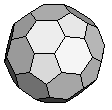 |
| Cube | Truncated Icosohedron |
| Solid Name | Signature | Click Image to View in Archimedean |
|---|---|---|
| Tetrahedron | {3,3,3} |  |
| Cube | {4,4,4} |  |
| Octahedron | {3,3,3,3} |  |
| Dodecahedron | {5,5,5} | 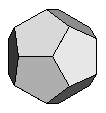 |
| Icosahedron | {3,3,3,3,3} | 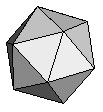 |
Platonic Requirements
Archimedes, in the 3rd century BC, discovered 13 regular polyhedra made of different polygon types in which the requirement that only one polygon type be used is relaxed.
| Solid Name | Signature | Click Image to View in Archimedean |
|---|---|---|
| Truncated Tetrahedron | {3,6,6} | 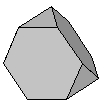 |
| Truncated Cube | {3,8,8} | 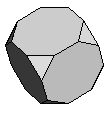 |
| Truncated Octahedron | {4,6,6} | 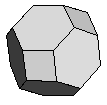 |
| Cuboctahedron | {3,4,3,4} | 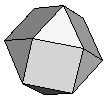 |
| Small Rhombicuboctahedron | {3,4,4,4} | 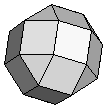 |
| Truncated Cuboctahedron | {4,6,8} | 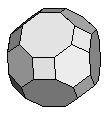 |
| Snub Cube | {3,3,3,3,4} | 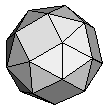 |
| Truncated Dodecahedron | {3,10,10} | 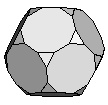 |
| Truncated Icosahedron | {5,6,6} |  |
| Icosidodecahedron | {3,5,3,5} | 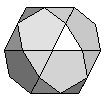 |
| Small Rhombicosidodecahedron | {3,4,5,4} | 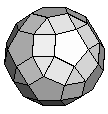 |
| Truncated Rhombicosidodecahedron | {4,6,10} | 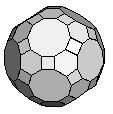 |
| Snub Dodecahedron | {3,3,3,3,5} | 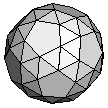 |
There is also a class of polyhedra known as the prisms and antiprisms of which there is an infinite variety. Technically, they conform to the definition of an Archimedean solid but they are not generally included with them. Prisms are formed of two squares and any other single polygon. Antiprisms are formed of three triangles and any other single polygon.
| Solid Name | Signature | Click Images to View in Archimedean |
|---|---|---|
| Prism | {4,4,*} |     etc. etc. |
| Antiprism | {3,3,3,*} | 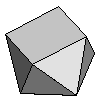    etc. etc. |
Archimedean Requirements
In 1619 AD, Johannes Kepler discovered two more solids by casting off the assumption that a regular polygon must be convex and also relaxing the requirement that sides shouldn't intersect. By joining pentagrams (the five pointed star known alternately as a star pentagon) three at a vertex, he discovered the Great Stellated Dodecahedron and by joining them five to a vertex, the Small Stellated Dodecahedron. These are known as the Kepler solids.
 |
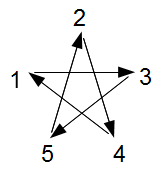 |
| Regular Pentagon (5/1) Five vertices, five edges |
Star Pentagon (5/2) Five vertices, five edges |
| Solid Name | Signature | Click Image to View in Archimedean | Building one Vertex | ||||||||||
|---|---|---|---|---|---|---|---|---|---|---|---|---|---|
| Great Stellated Dodecahedron | {5/2,5/2,5/2} | 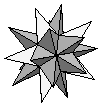 |
|
||||||||||
| Small Stellated Dodecahedron | {5/2,5/2,5/2,5/2,5/2} |  |
|
Kepler Requirements
In 1809, by allowing regular polygons to intersect each other, Louis Poinsot discovered the Great Dodecahedron which is made of 5 pentagons at each vertex, circumnavigating the vertex twice before joining up, and the Great Icosahedron which is made of 5 triangles at each vertex also circumnavigating the vertex twice before joining up. These are known as the Poinsot solids. The Poinsot solids are very closely related to the Kepler solids and they are often referred to collectively as the Kepler-Poinsot solids.
| Solid Name | Signature | Click Image to View in Archimedean | Building one Vertex | ||||||||||
|---|---|---|---|---|---|---|---|---|---|---|---|---|---|
| Great Dodecahedron | {5,5,5,5,5}/2 | 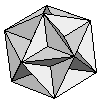 |
|
||||||||||
| Great Icosahedron | {3,3,3,3,3}/2 |  |
|
Poinsot Requirements
 |
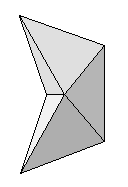 |
| 5 convex joins | 4 convex joins 1 concave join |
From the year 1878 - 1947, by relaxing every requirement except that all corners be the same, 53 more solids were discovered (and rediscovered) by various mathematicians including Edmund Hess (1878), Albert Badoureau (1881), Pitsch (1881), H.S.M. Coxeter and J. C. P. Miller (1930–1932), M.S. Longuet-Higgins and H.C. Longuet-Higgins. These are collectively known as the nonregular star polyhedra.
| Solid Name | Signature | Click Image to View in Archimedean |
|---|---|---|
| Great Cubicuboctahedron | {8/3,3,8/3,4} | 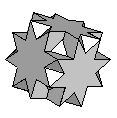 |
| Cubitruncated Cuboctahedron | {8/3,6,8} | 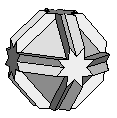 |
| Stellated Truncated Hexahedron | {8/3,8/3,3} | 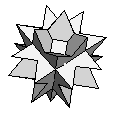 |
| Great Truncated Cuboctahedron | {8/3,4,6} | 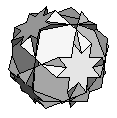 |
| Small Ditrigonal Icosidodecahedron | {5/2,3,5/2,3,5/2,3} | 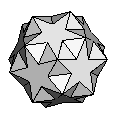 |
| Small Icosicosidodecahedron | {6,5/2,6,3} | 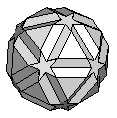 |
| Small Snub Icosicosidodecahedron | {3,5/2,3,3,3,3} | 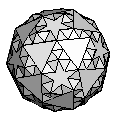 |
| Dodecadodecahedron | {5/2,5,5/2,5} | 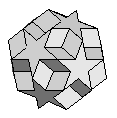 |
| Truncated Great Dodecahedron | {10,10,5/2} | 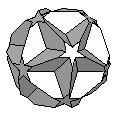 |
| Rhombidodecadodecahedron | {4,5/2,4,5} | 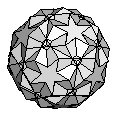 |
| Snub Dodecadodecahedron | {3,3,5/2,3,5} | 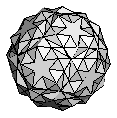 |
| Great Ditrigonal Dodecicosidodecahedron | {10/3,3,10/3,5} | 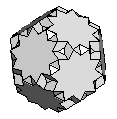 |
| Icositruncated Dodecadodecahedron | {10/3,6,10} | 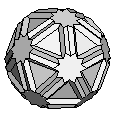 |
| Great Icosidodecahedron | {5/2,3,5/2,3} | 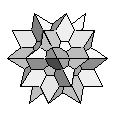 |
| Great Truncated Icosahedron | {6,6,5/2} | 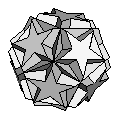 |
| Great Snub Icosidodecahedron | {3,3,5/2,3,3} | 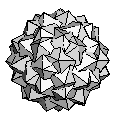 |
| Small Stellated Truncated Dodecahedron | {10/3,10/3,5} | 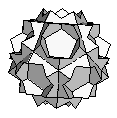 |
| Truncated Dodecadodecahedron | {10/3,4,10} | 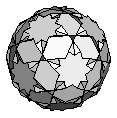 |
| Great Dodecicosidodecahedron | {10/3,5/2,10/3,3} | 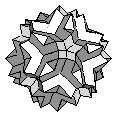 |
| Great Stellated Truncated Dodecahedron | {10/3,10/3,3} | 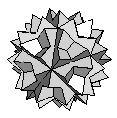 |
| Great Truncated Icosidodecahedron | {10/3,4,6} | 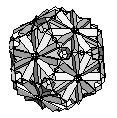 |
| Great Retrosnub Icosidodecahedron | {3,3,3,3,5/2}/2 | 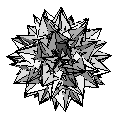 |
| Great Ditrigonal Icosidodecahedron | {3,5,3,5,3,5}/2 | 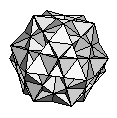 |
| Octahemioctahedron | {6,3/2,6,3} | 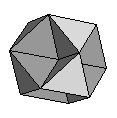 |
| Tetrahemihexahedron | {4,3/2,4,3} | 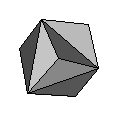 |
| Small Cubicuboctahedron | {8,3/2,8,4} | 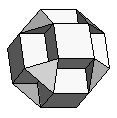 |
| Cubohemioctahedron | {6,4/3,6,4} | 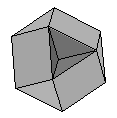 |
| Great Rhombicuboctahedron | {4,3/2,4,4} | 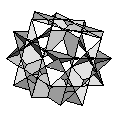 |
| Small Rhombihexahedron | {8,4,8/7,4/3} | 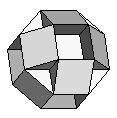 |
| Small Dodecicosidodecahedron | {10,3/2,10,5} | 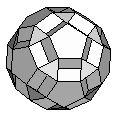 |
| Small Rhombidodecahedron | {10,4,10/9,4/3} | 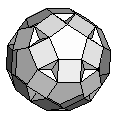 |
| Great Icosicosidodecahedron | {6,3/2,6,5} | 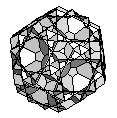 |
| Small Icosihemidodecahedron | {10,3/2,10,3} | 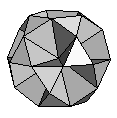 |
| Small Dodecicosahedron | {10,6,10/9,6/5} | 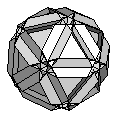 |
| Small Dodecahemidodecahedron | {10,5/4,10,5} | 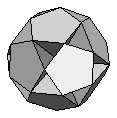 |
| Rhombicosahedron | {6,4,6/5,4/3} | 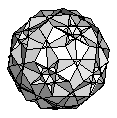 |
| Great Dodecahemicosahedron | {6,5/4,6,5} | 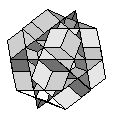 |
| Great Rhombihexahedron | {4,8/3,4/3,8/5} | 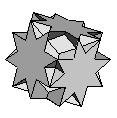 |
| Ditrigonal Dodecadodecahedron | {5/3,5,5/3,5,5/3,5} |  |
| Small Ditrigonal Dodecicosidodecahedron | {10,5/3,10,3} | 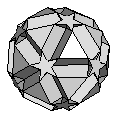 |
| Icosidodecadodecahedron | {6,5/3,6,5} | 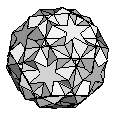 |
| Snub Icosidodecadodecahedron | {3,5/3,3,3,3,5} | 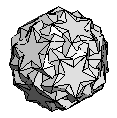 |
| Inverted Snub Dodecadodecahedron | {3,5/3,3,3,5} | 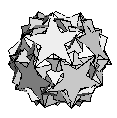 |
| Small Dodecahemicosahedron | {6,5/3,6,5/2} | 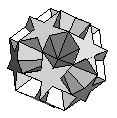 |
| Great Dodecicosahedron | {6,10/3,6/5,10/7} | 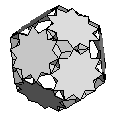 |
| Great Snub Dodecicosidodecahedron | {3,5/3,3,5/2,3,3} | 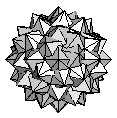 |
| Great Rhombicosidodecahedron | {4,5/3,4,3} | 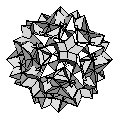 |
| Great Inverted Snub Icosidodecahedron | {3,5/3,3,3,3} | 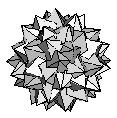 |
| Great Dodecahemidodecahedron | {10/3,5/3,10/3,5/2} | 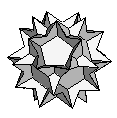 |
| Great Icosihemidodecahedron | {10/3,3/2,10/3,3} | 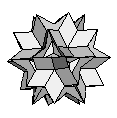 |
| Small Retrosnub Icosicosidodecahedron | {3,3,3,3,3,5/3}/2 | 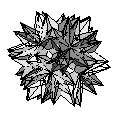 |
| Great Rhombidodecahedron | {4,10/3,4/3,10/7} | 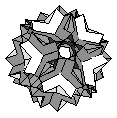 |
| Great Dirhombicosidodecahedron | {4,5/3,4,3,4,5/2,4,3/2}/2 | 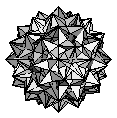 |
In 1966, Norman Johnson discovered 92 more polyhedra by relaxing the requirement that the vertices be the same. Here is a sampling of the many Johnson solids.
| Solid Name | Johnson Code | |
|---|---|---|
| Elongated Square Cupola | J19 | 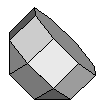 |
| Metabidiminished Icosahedron | J62 | 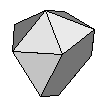 |
| Tridiminished Rhombicosidodecahedron | J83 | 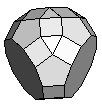 |
Johnson Requirements
Kasparian Solids were discovered by Raffi Jacques Kasparian in 1998
while writing a virtual polyhedra construction tool, named
"Archimedean", designed to build polyhedra where all corners match an
arbitrary given definition. Its method was to build one corner
according to the given definition and then to continue to propogate
corners until all unconnected edges joined with preexisting edges. As
more and more corners were built in this manner, the prospective solid
would gradually become a quasi-spherical shell. If there was no way to
complete the solid before sides began to intersect each other,
construction would be abandoned. On the other hand, if all edges
eventually joined before any sides intersected, then the solid would
be complete and would have been empirically proven to exist. During
the process of development of Archimedean, it was discovered that some
unrecognized solids could be constructed if sides were allowed to
traverse the quasi-spherical shell more than once in their attempt to
complete the solid. Kasparian solids are the result of relaxing the
tacit assumption that the sides of a polyhedron may traverse the
quasi-spherical shell only once in an attempt to join all edges.
Sides intersect in the Kasparian solids as they do in other solids but
they differ in the manner in which they intersect. In Poinsot solids
and some of the star polyhedra, sides intersect as they form a corner
by circumnavigating the vertex twice before joining each other. In
many of the star polyhedra, sides intersect because the sides
themselves are made from polygons with intersecting line segments. In
Kasparian solids, sides intersect each other because they
circumnavigate the surface of the solid more than once before finally
joining each other. While it is easy to quantify the number of times
sides circumnavigate a vertex, it is less obvious how to quantify the
number of times the sides circumnavigate a surface. This new class of
solid is dubbed "Rational" because it seems self-evident that whatever
the eventual method for counting circumnavigations, the sides
certainly circumnavigate the surface a rational number of times.
| Kasparian Code | Signature | Click Image to View in Archimedean | One Corner Click to Play Construction Animation |
Edges |
|---|---|---|---|---|
| K1 | {3,3,4}+ | 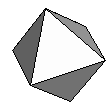 |
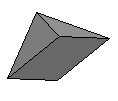 |
12:(3, 3, 4) |
| K2 | {3,4,5}+ |  |
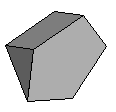 |
60:(3, 4, 5) |
| K3 | {3,4,6}+ |  |
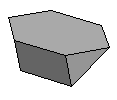 |
24:(3, 4, 6) |
| K4 | {3,5,5}+ | 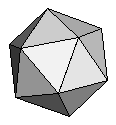 |
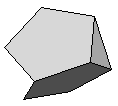 |
30:(3, 3, 5, 5) |
| K5 | {3,5,10}+ | 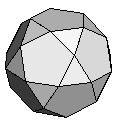 |
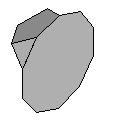 |
60:(3, 5, 10) |
| K6 | {3,6,10}+ | 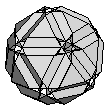
| 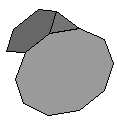 |
60:(3, 6, 10) 60:(6, 10) |
| K7 | {4,5,6}+ |  |
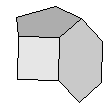 |
60:(4, 5, 6) 60:(4, 6) |
| K8 | {4,5,10}+ | 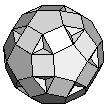 |
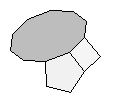 |
60:(4, 5, 10) 60:(4, 10) |
| K9 | {3,4,8}+ |  |
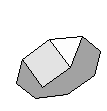 |
24:(3, 4, 8) 24:(4, 8) |
| K10 | {3,4,10}+ | 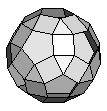 |
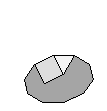 |
60:(3, 4, 10) 60:(4, 10) |
Kasparian Requirements
| K1 | Every edge is shared by two triangles and one square. (3, 3, 4) |
|---|---|
| K2 | Every edge is shared by one triangle, one square and one pentagon. (3, 4, 5) |
| K3 | Every edge is shared by one triangle, one square and one hexagon. (3, 4, 6) |
| K4 | Every edge is shared by two triangles and two pentagons. (3, 3, 5, 5) |
| K5 | Every edge is shared by one triangle, one pentagon and one decagon. (3, 5, 10) |
| K6 | Some edges are shared by one
triangle, one hexagon and one decagon. (3, 6, 10) Other edges are shared by only one hexagon and one decagon. (6, 10) |
| K7 | Some edges are shared by one
square, one pentagon and one hexagon. (4, 5, 6) Other edges are shared by only one square and one hexagon. (4, 6) |
| K8 | Some edges are shared by one
square, one pentagon and one decagon. (4, 5, 10) Other edges are shared by only one square and one decagon. (4, 10) |
| K9 | Some edges are shared by one
triangle, one square and one octagon. (3, 4, 8) Other edges are shared by only one square and one octagon. (4, 8) |
| K10 | Some edges are shared by one
triangle, one square and one decagon. (3, 4, 10) Other edges are shared by only one square and one decagon. (4, 10) |
| K1 is much like the Octahedron with 3 additional squares spanning the square spaces that naturally occur inside an Octahedron, | ||||
 |
= |  |
+ | 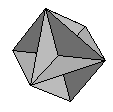 |
| K1 | Octahedron | 3 squares | ||
and K5 is much like the Icosidodecahedron with the addition of 6 decagons spanning the decagonal spaces that naturally occur inside an Icosidodecahedron. |
||||
 |
= |  |
+ | 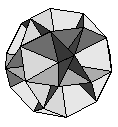 |
| K5 | Icosidodecahedron | 6 decagons | ||
| K4 can be decomposed into two known solids, the Icosahedron and the Great Dodecahedron. | |||||
 |
= |  |
+ | 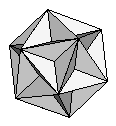 |
|
| K4 | Icosahedron | Great Dodecahedron | |||
| K3 shares the same vertices as the Cuboctahedron but connects them differently, | ||
 |
≈ |  |
| K3 | Cuboctahedron | |
and K8 shares the same vertices as the Small Rhombicosidodecahedron but connects them differently. |
||
 |
≈ |  |
| K8 | Small Rhombicosidodecahedron | |
| K2 contains within it 5 cubes plus an inner framework of pentagons and a shell with pentagonal holes that is made of intesecting triangles, | ||||||
 |
= | 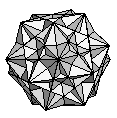 |
+ | 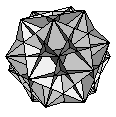 |
+ | 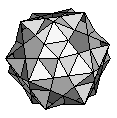 |
| K2 | 5 cubes | 12 pentagons | 30 intesecting triangles | |||
and it shares the same vertices as the Great Ditrigonal Icosidodecahedron but connects them differently. |
||||||
 |
≈ |  |
||||
| K2 | Great Ditrigonal Icosidodecahedron | |||||
| As far as my analysis has taken me, K6, K7, K9 and K10 do not contain within themselves any convex polyhedra. They do share the same vertices as some of the non-Rational polyhedra. | |||||
 |
≈ |  , , |
 , , |
 |
|
| K6 | Small Icosicosidodecahedron | Small Dodecicosahedron | Small Ditrigonal Dodecicosidodecahedron | ||
 |
≈ |  , , |
 , , |
 , , |
 |
| K7 | Small Snub Icosicosidodecahedron | Rhombidodecadodecahedron | Rhombicosahedron | Icosidodecadodecahedron | |
 |
≈ |  |
|||
| K9 | Small Rhombicuboctahedron | ||||
 |
≈ |  |
|||
| K10 | Small Rhombicosidodecahedron | ||||
| Signature | Click Image to View in Archimedean | Analysis | Edges |
|---|---|---|---|
| {3,3,5}+ |  |
= Great Dodecahedron + Icosahedron ≈ K4 |
30:(3, 3, 5, 5) |
| {3,4,10/3}+ | 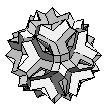 |
≈ Great Rhombidodecahedron | 60:(3, 4, 10/3) 60:(4, 10/3) |
| {5/2,10/3,4}+ | 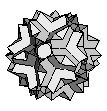 |
≈ Great Rhombidodecahedron | 120:(4, 5/2, 10/3) |
| {3,5/2,10/3}+ | 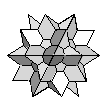 |
≈ Great Icosihemidodecahedron | 60:(3, 5/2, 10/3) |
| {3,8/3,4}+ | 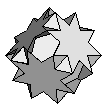 |
≈ Great Cubicuboctahedron | 24:(3, 4, 8/3) 24:(4, 8/3) |
| {3,10/3,6}+ | 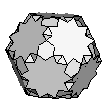 |
≈ Great Ditrigonal Dodecicosidodecahedron | 60:(3, 6, 10/3) 60:(6, 10/3) |
| {5,6,10/3}+ | 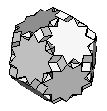 |
≈ Great Ditrigonal Dodecicosidodecahedron | 60:(5, 6, 10/3) 60:(6, 10/3) |
| {4,5/2,6}+ | 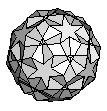 |
≈ Rhombidodecadodecahedron | 60:(4, 6, 5/2) 60:(4, 6) |
| {5,6,5/2}+ | 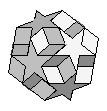 |
= Dodecadodecahedron + 10 hexagons | 60:(5, 6, 5/2) |
| {6,5/2,10}+ | 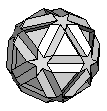 |
≈ Small Icosicosidodecahedron, Small Dodecicosahedron, Small Ditrigonal Dodecicosidodecahedron, K6 | 60:(6, 10, 5/2) 60:(6, 10) |
| {4,5/2,5}+ |  |
≈ Ditrigonal Dodecadodecahedron contains 5 cubes |
60:(4, 4, 5, 5/2) |
The following solids are grouped into families of identical polyhedra. They illustrate that multiple signatures can sometimes arrive at the same end result.
| Family | Signature | Click Image to View in Archimedean | Analysis | Edges |
|---|---|---|---|---|
| A | {3,3,5/2}+ | 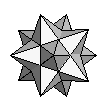 |
= Small Stellated Dodecahedron + Great Icosahedron | 30:(3, 3, 5, 5) |
| {5/2,5/2,3}+ | 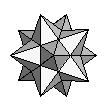 |
= Small Stellated Dodecahedron + Great Icosahedron | 30:(3, 3, 5, 5) | |
| {3,5/2,5/2,5/2}+ | 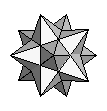 |
= Small Stellated Dodecahedron + Great Icosahedron Irregularities in building point to a possible bug in Archimedean. |
(3, 3, 5, 5) (3, 5, 5) |
|
| B | {3,5,3,5/2}+ | 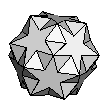 |
≈ Ditrigonal Dodecadodecahedron | 60:(3, 5, 5/2) |
| {5/2,3,5/2,5}+ | 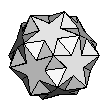 |
≈ Ditrigonal Dodecadodecahedron | 60:(3, 5, 5/2) | |
| C | {3,4,4,5/2}+ | 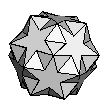 |
≈ Ditrigonal Dodecadodecahedron contains 5 cubes |
60:(3, 4, 4, 5/2) |
| {3,4,5/2,4}+ |  |
≈ Ditrigonal Dodecadodecahedron contains 5 cubes |
60:(3, 4, 4, 5/2) | |
| {3,5/2,4}+ |  |
≈ Ditrigonal Dodecadodecahedron contains 5 cubes |
60:(3, 4, 4, 5/2) | |
| {3,4,5/2,3,5/2}+ |  |
≈ Ditrigonal Dodecadodecahedron contains 5 partial cubes Irregularities in building point to a possible bug in Archimedean. |
(3, 4, 4, 5/2) (3, 4, 5/2) |